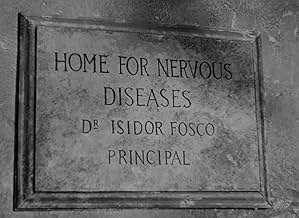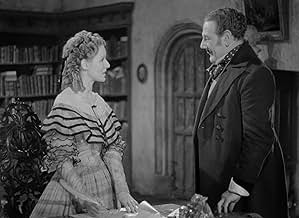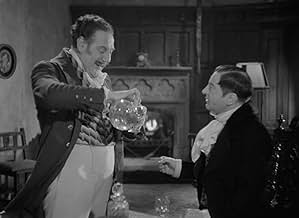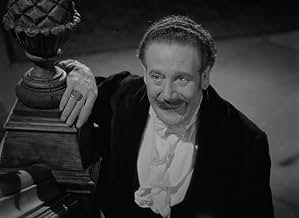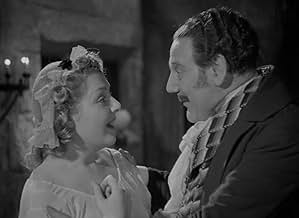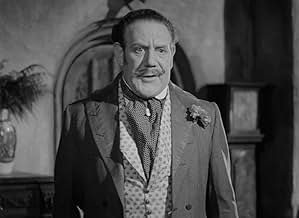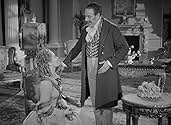NOTE IMDb
6,2/10
666
MA NOTE
Ajouter une intrigue dans votre langueA madman kills a man who has just inherited a large estate, then impersonates his victim to gain entrance to the estate so he can murder his enemies.A madman kills a man who has just inherited a large estate, then impersonates his victim to gain entrance to the estate so he can murder his enemies.A madman kills a man who has just inherited a large estate, then impersonates his victim to gain entrance to the estate so he can murder his enemies.
- Réalisation
- Scénario
- Casting principal
Grace Arnold
- Maid
- (non crédité)
Vincent Holman
- Asylum Doctor
- (non crédité)
Avis à la une
This movie is pretty darn delightful, right from the first scene where Mr. Tod Slaughter is seen hammering a spike into an unsuspectingly asleep man's head! He then impersonates the man, gaining admittance into the man's estate that had just been willed to him. You get to hear Tod say, "I'll feed your entrails to the pigs!"!! Don't pass up a chance to see it.
I have to admit to having never seen a Tod Slaughter movie. What a great screen presence. What an absolute cad. He is the consummate conniver and master of perversity. He kills a man in Australia and takes over his identity. He becomes the Lord of the Manor and runs the household on his own rancid terms. He gets a servant girl pregnant. He marries a local landowner's daughter and does anything to get his hands on the money available to him. There are some wonderful performances, especially that of Hay Petrie, the great sniveling character actor. He consorts with Slaughter with hopes of getting some of the money himself. There are convenient murders and acts of desperation. Through it all, Slaughter laughs at the suffering of others. There is only one person in his world.
The Woman in White, a great novel penned by Wilkie Collins, serves as the backbone for this Reader's Digest version of the novel adapted by Edward Dryhurst and produced/directed by Tod Slaughter regular George King. Slaughter also served as a producer, and this films has higher production values than most of Slaughter/King's previous efforts. While I enjoy the movie vastly, I am hesitant to call it the best of Slaughter's work. Give me The Face at the Window or even better Murder in the Red Barn where Slaughter leers more in one movie than twelve men could in twelve movies! Notwithstanding that this film is quite good as Slaughter opens the film drilling a nail/spike into a sleeping man's head in the Australian outback and assumes his identity going to England as the new lord of the manor. Slaughter immediately takes note of the young blonde maid who he raise up to chambermaid. With Slaughter's eyes rolling, his heavy-handed gesturing, and his tone and inflection, you know exactly what his intentions are at every moment. I know of no other actor who acts this way and could get away with acting this way. Slaughter does it so effortlessly, and let's be honest - if you are watching this film it is more than likely to see him. He is larger than life. The thickest slice of ham I have ever seen in films. The adaptation of Collin's novel has many shortcomings but stays surprisingly faithful to the main parts. The direction of King is adequate and the other performers are really rather good. Slaughter dispatches of people with glee and has some wonderful scenes with Hay Petrie as Isidor Fosco - a scoundrel of a different stripe so to say. Leering, drowning, hackling maniacally all are part of the Tod Slaughter package here. If you still have not seen one of his films, this one is as good as any to begin seeing what all the fuss - deserved and still not completed in any way - is about regarding Tod Slaughter.
It seems surprising - not knowing the copyright situation with Wilkie Collins original - that a quota quickie producer like George King should be able to get his hands on a respected literary source like THE WOMAN IN WHITE. However, the script rewrites the story so it is entirely told from the viewpoint of the false Sir Percival Glyde. Other adaptations might tell the tale from the viewpoint of the heroines as they struggle to unravel the mystery - but we are aware of the deception from the start as Tod creeps into a sleeping gold prospectors tent and dispatches him in a manner that suggests he's read Hamlet.
The disadvantage of this approach is that the fascinating, complex characters of Collins' text are flattened to one-dimensional cyphers. Laura is as much of a shrinking violet as she is in the novel but the fascinating figure of Marion (sapphic hints well suppressed here) is sidelined for much of the time. The annoyingly-hypochondriac Mr Fairlie seems more robust and more of a stock-comic figure. But the reduction of the fascinating figure of Count Fosco to Glyde's stooge is the most grievous oversight. Fosco - a roly-poly lovable eccentric who liked dogs and sunlight - was all the more chilling for being above suspicion unlike the obviously-villainous Glyde. For all that Hay Petrie brings to the part, it's just a shadow of what it could be. Still, Petrie and Slaughter make a fine pair of rogues - a cut-rate British version of Sidney Greenstreet and Peter Lorre.
What do we get in compensation for this? Two words - Tod Slaughter. His films are unique in that we get to view the story from the villain's perspective - imagine James Bond from Blofeld's viewpoint. He rises to the occasion here and is at his most lecherous - fixing his beady eyes on a comely maid whom he assigns "special duties", then strangles when she becomes inconveniently pregnant, gleefully snogging Laura upon first meeting her, and finally trying his evil way on her sister at the climax saying "I used to break precipitous horses in the Australian gold fields, and I'll enjoy breaking you!" Seldom has any villain cackled so evilly as Tod does here. Tod may start the film in an understated fashion as "Sir Percival" comes home but he's soon giving us the full melodramatic range - shifty up-to-no-good expression, comic exasperation as the bills pile up, and unashamed lechery as - convincingly sloshed on his wedding night - he ominously mounts the stairs as his squeamish bride waits fearfully in her bed. Incredibly, he is allowed to have his "wicked way" with her. Further examples of unbridled villainy include opening the window in the bedroom of the pneumonia-ridden Woman in White - having announced he expects a "change in her condition" - and luring one victim to her death saying she will, shortly, "be going on a long journey". Freddy Krueger could do with Tod's gag writers.
Something just occurred to me. We never discover the true identity of Tod's character. But examine the facts. A boozy, lecherous, overweight rogue from Australia who abuses a position of social authority and whose very repellent physical presence doesn't dampen his sex-drive for the ladies - was he Sir Les Patterson?
The disadvantage of this approach is that the fascinating, complex characters of Collins' text are flattened to one-dimensional cyphers. Laura is as much of a shrinking violet as she is in the novel but the fascinating figure of Marion (sapphic hints well suppressed here) is sidelined for much of the time. The annoyingly-hypochondriac Mr Fairlie seems more robust and more of a stock-comic figure. But the reduction of the fascinating figure of Count Fosco to Glyde's stooge is the most grievous oversight. Fosco - a roly-poly lovable eccentric who liked dogs and sunlight - was all the more chilling for being above suspicion unlike the obviously-villainous Glyde. For all that Hay Petrie brings to the part, it's just a shadow of what it could be. Still, Petrie and Slaughter make a fine pair of rogues - a cut-rate British version of Sidney Greenstreet and Peter Lorre.
What do we get in compensation for this? Two words - Tod Slaughter. His films are unique in that we get to view the story from the villain's perspective - imagine James Bond from Blofeld's viewpoint. He rises to the occasion here and is at his most lecherous - fixing his beady eyes on a comely maid whom he assigns "special duties", then strangles when she becomes inconveniently pregnant, gleefully snogging Laura upon first meeting her, and finally trying his evil way on her sister at the climax saying "I used to break precipitous horses in the Australian gold fields, and I'll enjoy breaking you!" Seldom has any villain cackled so evilly as Tod does here. Tod may start the film in an understated fashion as "Sir Percival" comes home but he's soon giving us the full melodramatic range - shifty up-to-no-good expression, comic exasperation as the bills pile up, and unashamed lechery as - convincingly sloshed on his wedding night - he ominously mounts the stairs as his squeamish bride waits fearfully in her bed. Incredibly, he is allowed to have his "wicked way" with her. Further examples of unbridled villainy include opening the window in the bedroom of the pneumonia-ridden Woman in White - having announced he expects a "change in her condition" - and luring one victim to her death saying she will, shortly, "be going on a long journey". Freddy Krueger could do with Tod's gag writers.
Something just occurred to me. We never discover the true identity of Tod's character. But examine the facts. A boozy, lecherous, overweight rogue from Australia who abuses a position of social authority and whose very repellent physical presence doesn't dampen his sex-drive for the ladies - was he Sir Les Patterson?
you just gotta love our evil character, he kills a guy in the beginning,, takes his ring,, his estate and takes over his whole entire life,, get's to marry one of the richest and prettiest maidens around,, he got a houseful of servants, and one cute one too boot, this movie is so funny , from start to end,, it was hard to keep a straight face,, so many lines from the butler , the lawyer, to sir Percival, were just too darn funny,, all of the killing he must do in order to keep his secret.. he has to get rid of several meddling people in order to keep everything on the up and up,, and the way he goes about it so nonchalant like it doesn't even bother him to kill these people.. and he is so jolly about it,, always twirling that mustache of his, there are a few people trying to stop him,, but they don't really show up till near the end of the movie. his assistant is probably the best character in the movie,, doesn't want to drink, but obliges, he get's cast deeper and deeper into Percival's sick plot, and soon the two are thick as thieves. well this was an amazing movie,, will watch again next year definitely.
Le saviez-vous
- AnecdotesVery loosely based on the 1859 novel "The Woman in White" by Wilkie Collins.
- GaffesWhen Marian Fairlie sneezes, Sir Frederick Fairlie complains about her spreading germs. But the story is set in the 1850s, and the germ theory of disease would not be known to the public until the 1870s.
- Citations
The False Percival Glyde: [after tying a noose around his victim's neck] You always said, you were a teetotaler. You're going to have a nice drop, now!
Meilleurs choix
Connectez-vous pour évaluer et suivre la liste de favoris afin de recevoir des recommandations personnalisées
- How long is Crimes at the Dark House?Alimenté par Alexa
Détails
- Date de sortie
- Pays d’origine
- Langue
- Aussi connu sous le nom de
- Crimes at the Dark House
- Société de production
- Voir plus de crédits d'entreprise sur IMDbPro
- Durée
- 1h 9min(69 min)
- Couleur
- Rapport de forme
- 1.37 : 1
Contribuer à cette page
Suggérer une modification ou ajouter du contenu manquant

